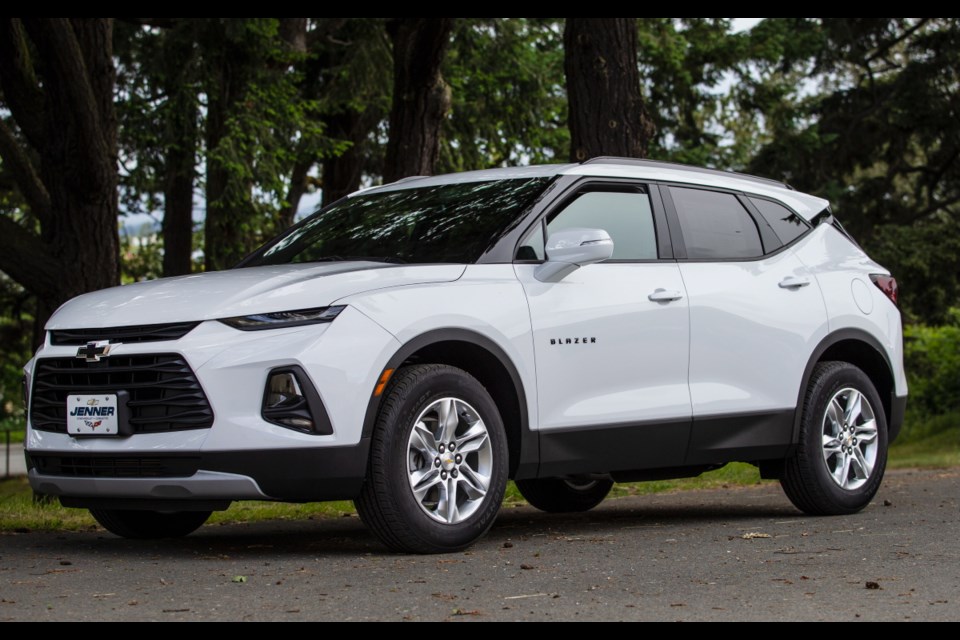General Motors revives an old nameplate and reimagines the new 2019 Chevrolet Blazer as a two-row crossover.
Manufacturers these days are increasingly looking for any reason to introduce a new SUV. Chevrolet has resurrected its Blazer name to capitalize on any goodwill that name has with consumers.
Those with a long memory can probably remember the original Blazer, which started off as a full-size two-door SUV based on the C/K pickup chassis in the late 1960s.
It transitioned into a midsize in the ’80s, again based on a truck — this time the smaller S-10.
It’s now back as a five-passenger midsized crossover, slotted between the Equinox and the Traverse in Chevrolet’s lineup. There is currently no equivalent vehicle in the GMC line.
There are four trim levels, starting with the Blazer 2.5L at $35,100. I drove the 3.6L, with a list price of $37,300.
It is logical to deduce that the numbers reflect the engine displacement between the two trims. The base engine is a 2.5-litre four-cylinder producing 193 horsepower. My tester had the more powerful (and popular) 3.6-litre V-6 producing 308 hp and 270 pound-feet of torque.
Both engines are mated to a nine-speed automatic.
You can save a few dollars by ordering the Blazer with just front-wheel drive. My tester had the optional all-wheel drive added, which bumped up the price to $40,300.
The double-overhead-cam engine is very smooth, with acceleration that impresses, especially on the highway. While I did not have the opportunity to test the Blazer’s towing abilities, it has a claimed maximum 2,041-kilogram (4,500 lbs.) capacity with the towing package.
If you do a lot of highway travel, you will appreciate the Active Fuel Management system, with a cylinder-deactivation system that shuts down two cylinders when driving under light loads.
In the city, the engine’s stop/start technology is handy in stop-and-go traffic. The Blazer is rated at 12.7 litres per 100 kilometres in the city and 9.5 on the highway.
Also helpful is a dial that allows the driver to choose the traction mode based on road conditions. You can choose two-wheel drive, four-wheel, sport off-road or towing.
Chevrolet took the time to nail down the finer details of design. Case in point is the climate control embedded in the bezels of a pair of interior vents, soft-touch materials where they matter most and the use of complementary colours to get away from a monochromatic interior.
The front seats were supportive, but I found the bolsters on the seat bottom were soft — I have my doubts about them holding up for the long term.
Chevrolet manages to get the 8.0-inch touchscreen at an optimum height without having it jut up on the dash, as many other manufacturers do. The operating system’s interface seems simple and easy to navigate.
My tester was lightly optioned, but the Blazer can be ordered with cutting-edge technology, including a 4G LTE mobile hotspot and wireless charging.
If you have children, I guarantee they will beg you to get the mobile hotspot.
The back seats were designed for adults in mind, with ample head and legroom. If you have lanky teenagers with limbs everywhere, being cramped isn’t a complaint you will likely hear.
The seatbacks fold 60/40 and, when deployed, you get a flat surface to carry up to 1,818 litres of cargo.
My complaint is that the most advanced driver assistance features, such as front pedestrian braking, automatic braking, collision alert and lane-keep assist with lane-departure warning, are only available in the RS and Premier trim levels.
My tester had a Plus Package, which included lane change, side blind zone and rear cross-traffic alerts. It also adds a rear park assist to the back-up camera.
One emerging safety feature — a rear seat reminder — is thankfully standard on all trim levels. It is activated when the rear doors are open or closed up to 10 minutes before, or anytime the vehicle is switched on.
If you have a young driver in the family, you will appreciate the Teen Driver suite. The suite includes Buckle to Drive, which means the vehicle will not start until the seat belt is fastened. Parents can also set an over-speed warning alert, with both a warning sound and logging the infraction. The vehicle will also let parents know if the forward collision alert has been set off (on vehicles equipped with the option).
The Blazer has undergone several revisions over its life. Its latest puts it in the sweet spot for buyers who have outgrown compact offerings but don’t need an extra two seats. In a battle between overall comfort and the ability to carry two more occupants, the Blazer prevails.
THE SPEC SHEET
Type: Mid-sized crossover/SUV, front engine, all-wheel-drive
Engine: 3.6-litre V-6, 308 hp at 6,600 rpm, 270 lb.-ft. of torque at 5,000 rpm
Transmission: Nine speed automatic
Dimensions (mm): Length, 4,862; width, (without mirrors) 1,948; height, 1,702; wheelbase, 2,863
Curb weight (kg): 1,910
Price (base/as tested): $40,300/ $43,890 (includes $1,895 freight and PDI and $100 AC tax)
Options: Plus Package $1,595
Tires: 235/55 R20 on alloy wheels
Fuel type: Regular
Fuel economy (L/100km): 12.7 city/ 9.5 highway
Warranty: Three years/60,000 km new car, five years/100,000 km powertrain and roadside assistance



